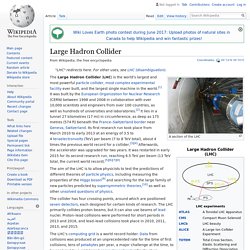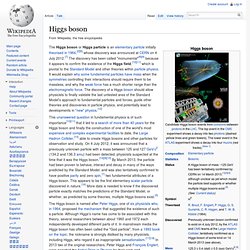

Large Hadron Collider. The Large Hadron Collider (LHC) is the world's largest and most powerful particle collider, most complex experimental facility ever built, and the largest single machine in the world.[1] It was built by the European Organization for Nuclear Research (CERN) between 1998 and 2008 in collaboration with over 10,000 scientists and engineers from over 100 countries, as well as hundreds of universities and laboratories.[2] It lies in a tunnel 27 kilometres (17 mi) in circumference, as deep as 175 metres (574 ft) beneath the France–Switzerland border near Geneva, Switzerland.

Its first research run took place from March 2010 to early 2013 at an energy of 3.5 to 4 teraelectronvolts (TeV) per beam (7 to 8 TeV total), about 4 times the previous world record for a collider,[3][4] Afterwards, the accelerator was upgraded for two years. It was restarted in early 2015 for its second research run, reaching 6.5 TeV per beam (13 TeV total, the current world record).[5][6][7][8] Higgs boson. The Higgs boson is named after Peter Higgs, one of six physicists who, in 1964, proposed the mechanism that suggested the existence of such a particle.

Although Higgs's name has come to be associated with this theory, several researchers between about 1960 and 1972 each independently developed different parts of it. In mainstream media the Higgs boson has often been called the "God particle", from a 1993 book on the topic; the nickname is strongly disliked by many physicists, including Higgs, who regard it as inappropriate sensationalism.[17][18] In 2013 two of the original researchers, Peter Higgs and François Englert, were awarded the Nobel Prize in Physics for their work and prediction[19] (Englert's co-researcher Robert Brout had died in 2011). A non-technical summary[edit] "Higgs" terminology[edit] Overview[edit] If this field did exist, this would be a monumental discovery for science and human knowledge, and is expected to open doorways to new knowledge in many fields.
History[edit] Akashic records. Background[edit] Akasha is a Sanskrit word meaning "sky", "space" or "aether", and it entered the language of theosophy through H.

P. Blavatsky, who characterized it as a sort of life force; she also referred to "indestructible tablets of the astral light" recording both the past and future of human thought and action, but she did not explicitly identify these as "akashic" in nature.[1] The notion of an akashic record is attributed to Alfred Percy Sinnett, who, in his book Esoteric Buddhism (1884), wrote of a Buddhist belief in "a permanency of records in the Akasa" and "the potential capacity of man to read the same. "[2][1] By C. Accounts of purported akashic access[edit] Readings of the akashic record were central to theosophist writings, but also appear in writings of other related figures. Alice A.
"The akashic record is like an immense photographic film, registering all the desires and earth experiences of our planet. Levi H. Wormhole. A wormhole, officially known as an Einstein–Rosen bridge, is a hypothetical topological feature of spacetime that would fundamentally be a "shortcut" through spacetime.

A wormhole is much like a tunnel with two ends each in separate points in spacetime. For a simplified notion of a wormhole, visualize space as a two-dimensional (2D) surface. In this case, a wormhole can be pictured as a hole in that surface that leads into a 3D tube (the inside surface of a cylinder). This tube then re-emerges at another location on the 2D surface with a similar hole as the entrance. An actual wormhole would be analogous to this but with the spatial dimensions raised by one.
Researchers have no observational evidence for wormholes, but the equations of the theory of general relativity have valid solutions that contain wormholes. "Embedding diagram" of a Schwarzschild wormhole (see below). Definition[edit] Characterizing inter-universe wormholes is more difficult.